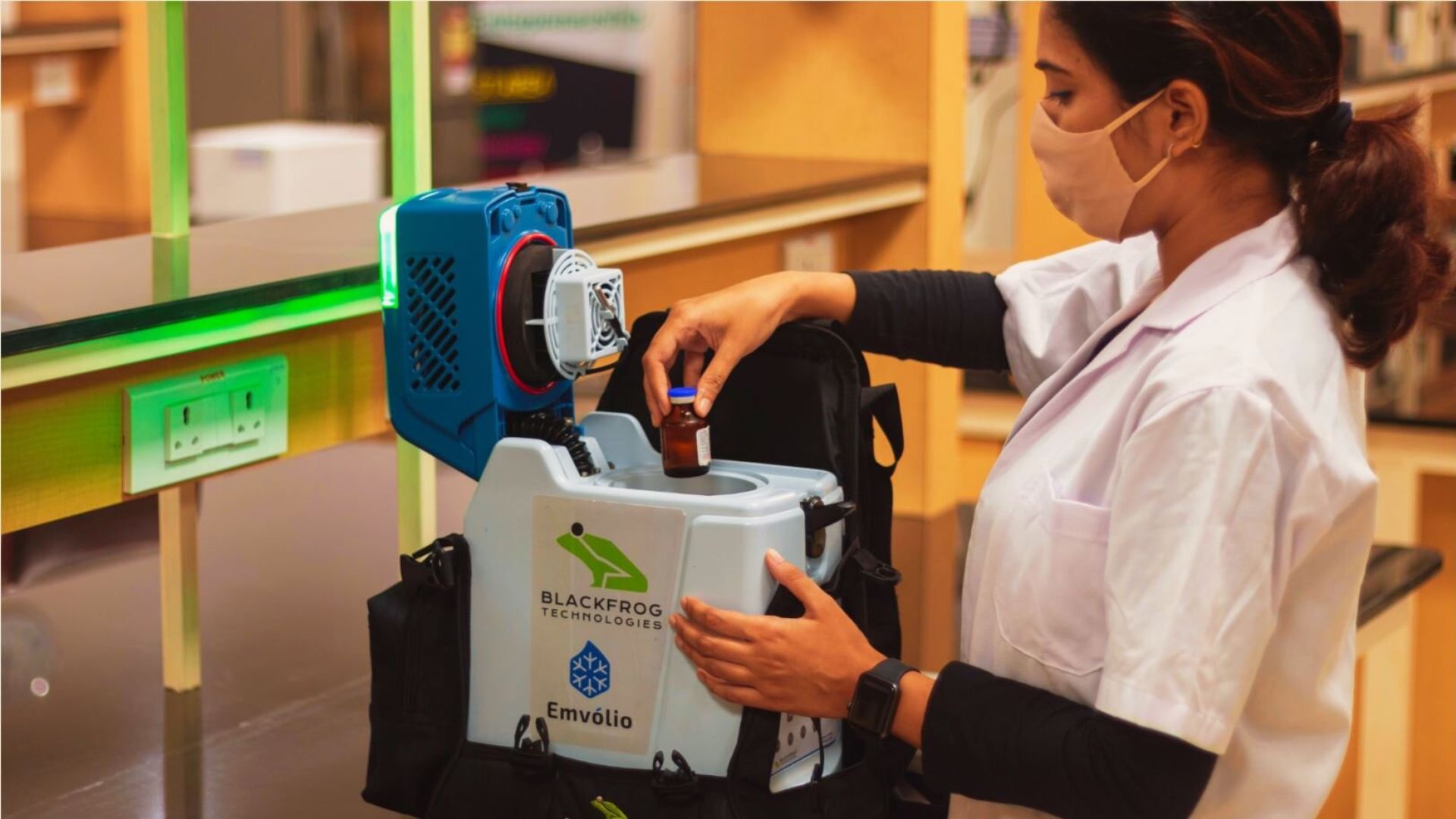Blending financing can offset risk, attract multipartner investment and scale up innovations for wide-reaching impact.
July 2022

Blackfrog Technologies’ Emvólio is a portable, active cooling, battery-powered device that helps efficiently deliver Covid-19 vaccines across India. Courtesy USAID/India.
Created in 2020, SAMRIDH Healthcare Blended Finance Facility utilizes blended financing models to create market-based health solutions. It is structured as a multisectoral partnership, with support from the government, development agencies and private sector partners, including entrepreneurs, accelerators and financial institutions, and academia. Blended finance allows SAMRIDH to enable health innovations, which can subsequently be replicated at scale, and achieve wide-reaching sustainable development outcomes.
“The model leverages collaborative investments by combining funds from philanthropic groups to serve as the catalytic capital able to mitigate market barriers and attract private sector investment,” says Neeta Rao, senior health specialist at the U.S. Agency for International Development, India, which is supporting SAMRIDH in collaboration with the Indian Institute of Technology Delhi, Atal Innovation Mission (NITI Aayog), principal scientific advisor to the Government of India, and the National Health Authority.
Implementing and scaling health solutions is a complex and expensive endeavor. When there is an insufficient budget allocated to health care needs, private sector investments can play a critical role in providing supplemental financing. Yet, investors are deterred from making investments in health care when there is perceived high financial risk and low return profiles of health businesses in comparison to investments in other sectors.
Blended financing helps overcome these deterrents and brings innovations to the broader marketplace. “In part because risks are absorbed by funding from philanthropic groups,” Rao continues, “the project becomes more attractive to the private investors seeking market-rate returns at lower risk. In effect, blended finance facilitates greater commercial investments toward scaling solutions with the potential to significantly improve the well-being of low-income groups.”
Anand Madanagopal, founder and CEO of Cardiac Design Labs, says SAMRIDH’s support was key to ensure that its wearable telemetric monitoring device, Padma Vitals, was made accessible to vulnerable communities. According to him, the support received through the initiative enabled “timely procurement of Padma Vitals devices” and better product outreach. “This collaboration has set us on the path to achieve financial sustainability in the long run,” he says.
Currently, top priority health innovations are focused on the Covid-19 pandemic. SAMRIDH works on finding high impact solutions, particularly within the areas of personal protective equipment, oxygen supply, health infrastructure, supply chain management, primary health care, telemedicine and Internet of Things (IoT)-enabled medical devices. As Covid-19 moves into its endemic phase, focus will shift to the underlying health systems, including monitoring and detecting new variants, strengthening the capacity of health care systems and increasing global access to vaccines.
For Nikhilesh Tiwari, director of Collateral Medical Pvt Ltd, SAMRIDH’s support during the pandemic was crucial in accelerating the supply of oxygen concentrators to health care units. “During the peak of the pandemic, SAMRIDH aided us in securing a working capital term loan, which enabled us to accelerate the supply of oxygen concentrators,” he explains. “The funding and advisory services we received from SAMRIDH enabled us to manage our cash flow more effectively, cut operating expenses, and use the savings as cash collateral to secure a working capital term loan from an impact investment firm. The capital raised allowed us to enhance our ability to fulfill immediate orders and expand our offerings in the health care vertical.”
Another success story of SAMRIDH blended financing is Blackfrog Technologies—a health-tech company specializing in the last mile delivery of medical supplies and specimens. Its ground-breaking innovation, Emvólio—a portable, active cooling, battery-powered device–delivers Covid-19 vaccines across India. “The impact funding and risk guarantee received from SAMRIDH has been instrumental for Blackfrog to raise commercial capital from financial institutions,” says Donson D’Souza, co-founder and COO of Blackfrog Technologies. “This has enabled us to scale up our manufacturing capacity for Emvólio and cater to markets across India and overseas.”
Blending financing models also have challenges. High transaction costs and long timelines in structuring blended finance solutions, regulatory challenges and legal frameworks that limit the flow of capital, and the lack of private sector mobilization can cause impediments to the wide-reaching impact of important health innovations.
A successful blended finance structure includes the right combination of debt, equity and grant financing, along with pre-determined terms for each investor to absorb losses and earn returns. “The model is especially relevant for sunrise and undercapitalized sectors, such as the domestic health care industry in India, where the flow of private capital is constrained by investors’ perceptions of high risks and low returns,” says Rao. Blended finance is an important tool for long-term positive impact in offsetting risk, attracting investment and bringing affordable health care innovation to scale.
Natasa Milas is a freelance writer based in New York City.
COMMENTS